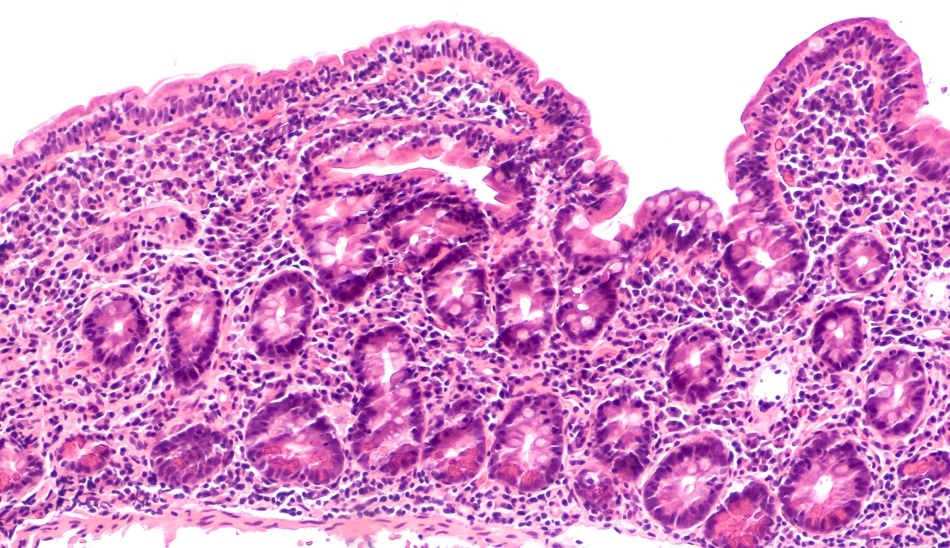
Image credits: David A. Litman/shutterstock.com
Advances made during recent clinical trials mean that those suffering from celiac disease may soon be able to reintroduce gluten back into their diet. This breakthrough is down to a progressive new treatment that makes innovative use of nanotechnology.
Developed by a team of researchers at Northwestern University, the treatment deploys a biodegradable nanoparticle with a gluten core. By building a shell around the gluten compound (gliadin) the Northwestern team could train the immune system to accept the compound into the body. During the phase-2 trial, patients that received the treatment demonstrated a significantly reduced autoimmune response versus patients that received a placebo.
This is the first demonstration the technology works in patients.
Dr. Stephen Miller, Professor of Microbiology-immunology, Northwestern Medicine
As well as treating celiac disease the technology could be applied to treat a multitude of other autoimmune diseases and allergies. "We have also shown that we can encapsulate myelin into the nanoparticle to induce tolerance to that substance in multiple sclerosis models or put a protein from pancreatic beta cells to induce tolerance to insulin in type 1 diabetes models," added Miller.
Acting as a kind of Trojan Horse, the shell of the nanotechnology protects the gluten core from the body’s immune system and instead treats it as non-hostile and safe. Once in the blood-stream the nanoparticle is eventually consumed by a macrophage, referred to as a ‘vacuum-cleaner cell.’
The vacuum-cleaner cell presents the allergen or antigen to the immune system in a way that says, ‘No worries, this belongs here. The immune system then shuts down its attack on the allergen, and the immune system is reset to normal.
Dr. Stephen Miller
Post-treatment, patients that displayed positive results were able to ingest gluten without experiencing increased inflammation, protecting the small intestine from gluten exposure. This offers those diagnosed with the disorder a new hope as currently there is no direct treatment for celiac disease. "Doctors can only prescribe gluten avoidance, which is not always effective and carries a heavy social and economic toll for celiac patients," Miller said.
The findings of the study were revealed as a late-breaking presentation earlier this week at the European Gastroenterology Week conference in Barcelona, Spain.
Celiac disease is not an allergy or intolerance to gluten (a protein found in wheat, barley, and rye); it is a serious autoimmune condition that can lead to damage of the small intestine after repeated exposure to the protein. The body’s response, when gluten is ingested, is to set in motion a response from the immune system which mistakenly attacks healthy tissue. This can eventually lead to other problems such as dermatitis, fatigue, and nerve damage.
Generally, autoimmune diseases can only be treated with certain immune suppressants, but this can compromise the immune system and lead to other toxic side-effects. However, the Northwestern team’s nanotechnology (CNP-101) has exhibited an ability to reverse the course of disease when effective.
"Celiac disease is unlike many other autoimmune disorders because the offending antigen (environmental trigger) is well known -- gluten in the diet," said Dr. Ciaran Kelly, professor of medicine at Harvard Medical School and director of the Celiac Center at Beth Israel Deaconess Medical Center. "This makes celiac disease a perfect condition to address using this exciting nanoparticle induced immune tolerance approach."
Kelly, who delivered the late-breaking presentation in Barcelona, worked closely with Miller when addressing the applications and therapeutic approach where CP-101 nanotechnology is concerned. The next stage of the process is to move to phase-3 trials to determine safety and effectiveness of the treatment.
While the results of the first human trials (phase-2) were mostly positive there are still hurdles to overcome – the US Food and Drug administration state that of all treatments that make it to phase-3 it is typical for only 25-30 percent of those treatments are successful.
While CP-101 nanotechnology has been licensed to COUR Pharmaceuticals Co., a biotech firm founded by Miller, Takeda Pharmaceuticals has announced an exclusive license to develop and commercialize the technology for celiac disease. "Given the license by Takeda, COUR will focus on clinical programs in peanut allergy and multiple sclerosis in the near term, and broaden even further over time," said John J. Puisis, president and chief executive officer of COUR.
Disclaimer: The views expressed here are those of the author expressed in their private capacity and do not necessarily represent the views of AZoM.com Limited T/A AZoNetwork the owner and operator of this website. This disclaimer forms part of the Terms and conditions of use of this website.